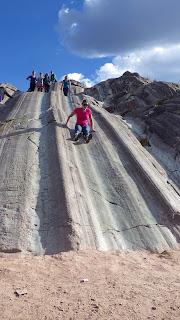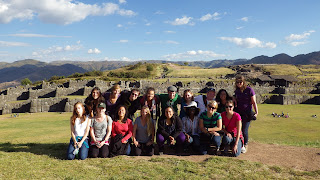Happy as a clam (photo credit Alisha Thompson).
Adrienne playing on a natural slide at Saksaywaman.
Group shot in front of Saksaywaman.
A geologist always nose.
Bad ass rock work. Check it.
Mi segundo novio peruano (after Wong, before la S)...
San Luis=7 liters of pure love.
Thursday we woke up BALLS early to head to the rural community of Chahuay. We spent the morning learning about Sierra Productiva (an NGO that helps indigenous communities develop sustainable agriculture: http://www.sierraproductiva.org/) and visiting with campesinos. After a delicious traditional lunch we headed to Casa Hogar Maria de Nazareth, a shelter for at risk girls. Every year the IFSA students trade performances with the girls, and every year IFSA students pull together their show on the bus en route to the Casa Hogar. After much debate we settled on: "Barbara Anne", "Can You Feel the Love Tonight" (featuring Mikey as Timon, Logan as Simba, Adrienne as Nala, and Me as Pumba), and "Wanna Be" for our show.
Compañero Francisco and company preparing a delicious breakfast...
Hard boiled eggs, GIANT lima beans, choclo, fish, and pancito.
This is paradise...
Enroute to the cerro mirador
Made it.
Alisha hamming it up with the locals.
Watching the girls perform (photo credit Laura Balbuena).
Exchanging gifts (photo credit Laura Balbuena).
Dancing...the "Macarena" may have happened at one point
(photo credit Laura Balabuena).
Wish I was joking, but here is "Barbie Girl" in quechua.
They played this at least 15 times during our visit.
On Friday we made a day out of our trip to Aguas Calientes. In the morning we stopped at the Awana Kancha Llama farm to pet llamas, learn about traditional textiles, and shop (although the high quality wools were a little out my price range). After lunch we checked out the ruins of Písac and Ollantaytambo as well as the Písac market. That night we took the train to Aguas Calientes-the world's most expensive town (on slice of pie=17 soles).
LLAMAS
Ruins of Písac
Tiwanaku style door way at Ollantaytambo.
Look mom we're window sized (photo credit Alisha Thompson).
Making our way to the top...
Looking down on the town of Ollantaytambo.
Group shot (photo credit Laura Balbuena).
Waiting in the train station after a long day...
Erin playing the part of hippy, backpacker, gringa tool.
The study table...very serious.
Erin, Adrienne, and I...
What a candid.
And then descended to explore the famous site...where I may or may not have urinated dos veces.
La luz andina
La Esparza (my Narrative professor) would be proud.
Exploring.
Adrienne, Sara, and Erin
Sara, Adrienne, and I in the famous three doorways...Peru's next top model?
Casual éxito in the Temple Circuit.
The Miraflores of Machu Picchu.














































